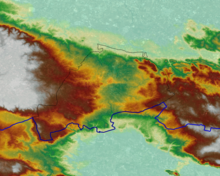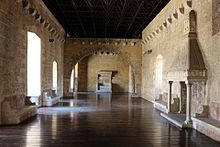
A | B | C | D | E | F | G | H | CH | I | J | K | L | M | N | O | P | Q | R | S | T | U | V | W | X | Y | Z | 0 | 1 | 2 | 3 | 4 | 5 | 6 | 7 | 8 | 9
Gioia del Colle | |
|---|---|
| Comune di Gioia del Colle | |
| Coordinates: 40°48′N 16°56′E / 40.800°N 16.933°E | |
| Country | Italy |
| Region | |
| Metropolitan city | Bari (BA) |
| Frazioni | Colonia Hanseniana, Corvello, La Torre, Casino Eramo e Marzagaglia, Monte Sannace, Montursi, Murgia, Santa Candida, Terzi, Villaggio Azzurro |
| Government | |
| • Mayor | Giovanni Mastrangelo (right wing) |
| Area | |
| • Total | 206.48 km2 (79.72 sq mi) |
| Elevation | 360 m (1,180 ft) |
| Population (1 January 2015)[2] | |
| • Total | 27,923 |
| • Density | 140/km2 (350/sq mi) |
| Demonym | Gioiesi |
| Time zone | UTC+1 (CET) |
| • Summer (DST) | UTC+2 (CEST) |
| Postal code | 70023 |
| Dialing code | 080 |
| ISTAT code | 072021 |
| Patron saint | Saint Philip Neri |
| Saint day | 26 May |
| Website | Official website |
Gioia del Colle (pronounced [ˈdʒɔːja del ˈkɔlle]; Barese: Sciò) is a town and comune of the Metropolitan City of Bari, Apulia, southern Italy. The town is located on the Murge plateau at 360 metres (1,180 ft) above sea level, between the Adriatic and Ionian seas.
Physical geography
Territory

Gioia del Colle is on the top of a hill at 360 m a.s.l. It is located in the southern part of the Murge, in the "Sella di Gioia del Colle". It is between the North-West Murge and the South-West Murge and the Adriatic Sea and the Ionian Sea. The municipal area has an area of 206.48 km2 and it reaches a maximum altitude of 435 m a.s.l. and a minimum of 296 m a.s.l. Its area borders to the North-West with Acquaviva delle Fonti, to the North with Sammichele di Bari, to the North-East with Turi, to the East with Putignano and Noci, to the South-East with Mottola, to the South with Castellaneta, to the South-West with Laterza and to the West with Santeramo in Colle.

The landscape is characterized by large wooded areas, in which the Macedonian oaks dominate, more than the downy oak. In particular the Bosco Romanazzi and Serra Capece constitute the most conspicuous part of the wooded area of Gioia del Colle and they extend from Mount Sannace archaeological area to the provincial road that leads to Noci.
The western part of the area is part of the North-West Murge, with isoipse that exceed 400 m a.s.l. towards Santeramo and Laterza, while the Eastern one is part of the South-East Murge, with isoipse over 400 m a.s.l. towards Noci. In the middle, on the contrary, there is a depression (saddle) with an average altitude of 340 m a.s.l., interrupted only by the 360-meter hill on which the city lies.
Climate
Gioia del Colle's climate is mediterranean (Köppen Csa), but it has peaks of continentality due to the altitude and the distance from the sea. Temperature varies between −2 e +12 °C in winter, while it varies between +18 e +35 °C with a high percentage of humidity in summer. Annual rainfall is around 600 mm. It often snows, about once a year, especially if there is cold air of Balkan origin.
| Climate data for Gioia del Colle (Gioia del Colle Air Base), 1991–2020 | |||||||||||||
|---|---|---|---|---|---|---|---|---|---|---|---|---|---|
| Month | Jan | Feb | Mar | Apr | May | Jun | Jul | Aug | Sep | Oct | Nov | Dec | Year |
| Mean daily maximum °C (°F) | 10.3 (50.5) |
10.8 (51.4) |
13.8 (56.8) |
17.4 (63.3) |
22.8 (73.0) |
28.0 (82.4) |
30.8 (87.4) |
31.1 (88.0) |
25.6 (78.1) |
20.5 (68.9) |
15.4 (59.7) |
11.3 (52.3) |
19.8 (67.6) |
| Daily mean °C (°F) | 6.3 (43.3) |
6.5 (43.7) |
8.9 (48.0) |
12.0 (53.6) |
16.8 (62.2) |
21.8 (71.2) |
24.4 (75.9) |
24.5 (76.1) |
19.8 (67.6) |
15.6 (60.1) |
11.4 (52.5) |
7.6 (45.7) |
14.6 (58.3) |
| Mean daily minimum °C (°F) | 2.5 (36.5) |
2.5 (36.5) |
4.4 (39.9) |
7.0 (44.6) |
11.0 (51.8) |
15.5 (59.9) |
17.9 (64.2) |
18.3 (64.9) |
14.7 (58.5) |
11.2 (52.2) |
7.6 (45.7) |
3.9 (39.0) |
9.7 (49.5) |
| Average precipitation mm (inches) | 60.2 (2.37) |
52.4 (2.06) |
64.7 (2.55) |
51.3 (2.02) |
43.0 (1.69) |
36.5 (1.44) |
24.1 (0.95) |
24.5 (0.96) |
69.4 (2.73) |
65.6 (2.58) |
78.5 (3.09) |
69.5 (2.74) |
639.8 (25.19) |
| Average precipitation days (≥ 1 mm) | 7.5 | 7.3 | 6.9 | 6.8 | 5.5 | 4.1 | 2.8 | 2.6 | 5.9 | 7.0 | 7.7 | 8.3 | 72.3 |
| Average relative humidity (%) | 79.6 | 75.9 | 74.2 | 73.4 | 70.4 | 65.5 | 63.0 | 64.5 | 70.7 | 77.1 | 80.8 | 80.9 | 73.0 |
| Average dew point °C (°F) | 3.5 (38.3) |
2.9 (37.2) |
4.9 (40.8) |
7.5 (45.5) |
10.9 (51.6) |
13.9 (57.0) |
15.3 (59.5) |
16.2 (61.2) |
14.5 (58.1) |
12.2 (54.0) |
8.8 (47.8) |
5.0 (41.0) |
9.6 (49.3) |
| Source: NOAA[3] | |||||||||||||
History

The current town of Gioia del Colle was born around Castello Normanno-Svevo, a castle of Byzantine origins.
Its name derives from Joha, a reduction of the surname Joannakis. It was a Byzantine family present in these places in the Middle Ages,[4] but there are many opinions and even legends on the origin of the toponym. One of the most famous is that according to a noble woman traveling in the lost area of jewels including a beautiful and precious necklace. The name "Gioia del Colle" was given to the place where the necklace was found. The complex and original history of the city of Gioia del Colle is also illustrated in its particular heraldic coat of arms: a goblet-shaped cup full of jewels and bordered by agricultural motifs. Unlike the coats of arms of the neighboring countries, that of Gioia del Colle, dating back to 1934, is not linked to any symbol depicting families, marquisates or duchies. It tells the presence of a heterogeneous civilization ranging from poverty to wealth, from crafts to large estates . It is inspired by a sculpture made in 1480 by Joannes de Rocca, on a stone walled in the University of Gioia's seat. It depicts three coats of arms: that of Gioia with the inscription Universitas Joe, the Aragonese one with the royal crown and that of the Acquaviva counts of Conversano.
The inhabited area was rebuilt by the Norman Richard of Hauteville, only to be destroyed by William I of Sicily. It was re-founded in 1230 by Frederick II of Swabia on his return from the Crusade. It seems that the castle was a residence where he stopped during his hunting trips. It was then completed by the Angevins who opened windows on the curtain.
Between 1600 and 1800 the successive owners (Acquaviva d'Aragona, the De Mari and Donna Maria Emanuela Caracciolo) removed the appearance of a fortified residence from the complex.
The "new" city, however, would have originated from a much older settlement: Monte Sannace, about 5 km away from today's town. Archaeological excavations, even today, bring to light the remains of a village of Peucetians dating back to the 7th century BC. Gioia was born during the Byzantine dominion and then passed under the Norman dominion, it was given to Count Richard of Hauteville. Frederick II was responsible for the reconstruction of the castle. It was principality of Taranto and fief of the De Mari princes of Acquaviva delle Fonti until the abolition of feudalism.

Marzagaglia's massacre
In 1920 the Marzagaglia massacre took place, in the difficult social and political climate of the first post-war period.[5] On 1 July 6 workers were killed and following day in retaliation three landowners.
Monuments and interesting places
Norman-Hohenstaufen castle

The Gioia del Colle Norman-Swabian Castle is the result of at least three construction interventions: one dating back to the Byzantine period, another to the Norman one and the last to the Swabian one. Initially it consisted of a fortified enclosure in stone ashlars. It was enlarged in the 12th century by the Norman Richard of Hauteville, who transformed it into a noble residence.
The final castle arrangement is due to Frederick II of Swabia around 1230. It has a quadrangular courtyard, halls and rooms that overlook it, and is bordered by four corner towers. Of the four original corner towers, which are mentioned in the book the Terra di Gioia both by the architect and tabular book Honofrio Tangho of 1640 and by Gennaro Pinto of 1653, today only two towers remain: that of De 'Rossi and that of the Empress.
The castle permanently houses the Gioia del Colle National Archaeological Museum.

The main Church
It was built towards the end of the 11th century by Riccardo Siniscalco with the name of "Palatine Church of St. Peter". It was initially dedicated to St. Peter, but it was later renamed "Madonna della Neve". The church was destroyed in 1764 by a fire. In the same year the church was rebuilt and dedicated to the nativity of the Blessed Virgin.This period dates back to the two stone sculptures on the front (S. Filippo Neri and the Madonna with the Child in her womb).
The church was damaged again in 1857, by an earthquake. It was then closed to worship. The church's front and the bell tower were restored in 1893.
The downfall of the bell tower dates back to 1942 and it is due to structural instability between the part built in the 12th century and that of 1893.
The Baptismal Books were established in the church in 1575 and the Registers of the Dead in 1584.
It has inside numerous frescoes dating back to different historical periods and a crypt in which the body of Prince Carlo III De' Mari is buried. It was rebuilt over the centuries, it still retains the original jamb of the entrance door and a sarcophagus used as a washbasin (preserved in the sacristy).
Other churches
- Parrocchia Sacro Cuore
- Parrocchia Santa Lucia
- Parrocchia San Vito
- Parrocchia Immacolata di Lourdes
- Parrocchia Madonna di Loreto
- Chiesa San Rocco
- Chiesa Sant'Angelo
- Chiesa Sant'Andrea
- Chiesa San Domenico Zdroj:https://en.wikipedia.org?pojem=Gioia_del_Colle_DOC
Text je dostupný za podmienok Creative Commons Attribution/Share-Alike License 3.0 Unported; prípadne za ďalších podmienok. Podrobnejšie informácie nájdete na stránke Podmienky použitia.
Antropológia
Aplikované vedy
Bibliometria
Dejiny vedy
Encyklopédie
Filozofia vedy
Forenzné vedy
Humanitné vedy
Knižničná veda
Kryogenika
Kryptológia
Kulturológia
Literárna veda
Medzidisciplinárne oblasti
Metódy kvantitatívnej analýzy
Metavedy
Metodika
Text je dostupný za podmienok Creative
Commons Attribution/Share-Alike License 3.0 Unported; prípadne za ďalších
podmienok.
Podrobnejšie informácie nájdete na stránke Podmienky
použitia.
www.astronomia.sk | www.biologia.sk | www.botanika.sk | www.dejiny.sk | www.economy.sk | www.elektrotechnika.sk | www.estetika.sk | www.farmakologia.sk | www.filozofia.sk | Fyzika | www.futurologia.sk | www.genetika.sk | www.chemia.sk | www.lingvistika.sk | www.politologia.sk | www.psychologia.sk | www.sexuologia.sk | www.sociologia.sk | www.veda.sk I www.zoologia.sk



